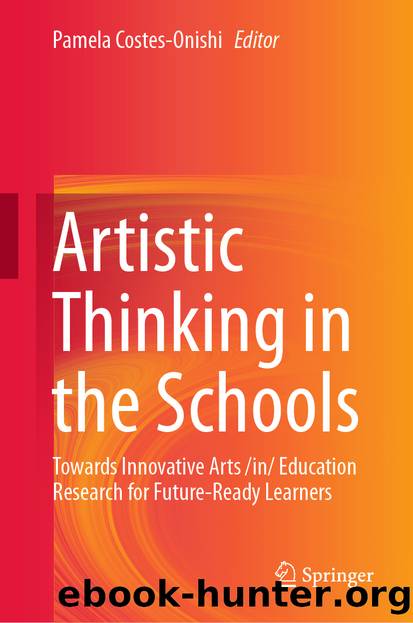Artistic Thinking in the Schools by Unknown

Author:Unknown
Language: eng
Format: epub
ISBN: 9789811389931
Publisher: Springer Singapore
Aesthetic Teaching as a Multilogical-Multifaceted Approach to the Subject Taught
Aesthetic teaching seems to cultivate a variety of ways of thinking and learning about a taught subject (Broda, 2010; Catterall, 2005; Deasy, 2002; Denac, 2014; Gardner, 1983, 1999a, b, 2006; Lynch, 2007; Markovic, 2011; Miller, 2007; Smithrim & Upitis, 2005; Upitis, 2011; Winner et al., 2013). That is, one aim of aesthetic teaching is for children to use the arts so that they can work with multiple types of perception and learning with regard to the taught subject.
For example, the activity described above was designed so that children could approach the subject spatially (while they are drawing), act upon their work with logic and verbally (while they were formulating and explaining their ideas), include interpersonal and intrapersonal thoughts (when they were thinking up stories and actions for the number taught), think in a kinetic and aural manner (when they were performing their ideas) or combine some of these or other ways of thinking. When the activities were implemented, while the grapheme 1 was being taught, the time devoted by each child to each manner of thought or activation was different: some children devoted greater time to the drawing (paying particular attention to the spatial aspects of the number), others focused more on the character they attributed to the number (e.g. why number 1 was the leader), others looked forward to presenting their ideas through movement in space, others focused on the sounds of their ideas, others focused on the emotions the numbers brought out in them (e.g. “my favourite number is 1”, “I don’t like number 1 at all”), others attributed interpersonal characteristics to numbers (“number 1 argued with all the rest”) and shared their meaning with the rest of the group (e.g. a little improvised sketch was performed spontaneously, in which “number 1 scolded all the rest of the numbers and they avoided number 1 so that it was left alone in the end”).
Aesthetic teaching activities should provide children with the opportunities to discover ways of understanding that are suitable to their learning style and to try out different ways of functioning intellectually. Pupils who take part in aesthetic teaching activities must not be limited by traditional manners of thought, the linguistic and logical, but also use the musical, spatial, kinaesthetic, interpersonal, intrapersonal and other manners. Thus, these activities must provide opportunities for children to be influenced by the taught subject, not only on an intellectual, but also on a bodily, social and emotional level.
Download
This site does not store any files on its server. We only index and link to content provided by other sites. Please contact the content providers to delete copyright contents if any and email us, we'll remove relevant links or contents immediately.
The Monuments Men by Robert M. Edsel(1485)
Things Are What You Make of Them: Life Advice for Creatives by Adam J. Kurtz(1450)
The Freelance Manifesto: A Field Guide for the Modern Motion Designer by Joey Korenman(1226)
101 Gag Ideas: Companion to the One Minute Caricature by James van der Keyl(1087)
Find Your Artistic Voice by Lisa Congdon(1057)
Boom by Michael Shnayerson(1024)
The Business of Being an Artist by Daniel Grant(973)
Your Art Will Save Your Life by Beth Pickens(949)
The Lady in Gold by Anne-marie O'connor(943)
Your Inner Critic Is a Big Jerk by Danielle Krysa(935)
Create Your Art Career by Rhonda Schaller(931)
Breakfast at Sotheby's(916)
Seven Days in the Art World by Sarah Thornton(914)
How to Survive and Prosper as an Artist by Caroll Michels(865)
33 Artists in 3 Acts by Sarah Thornton(853)
When Talent Isn't Enough: Business Basics for the Creatively Inclined by Kristen Fischer(837)
Art Held Hostage by John Anderson(826)
The Graphic Designer's Guide to Better Business Writing by Barbara Janoff & Ruth Cash-Smith(814)
Art of the Deal by Noah Horowitz(813)
